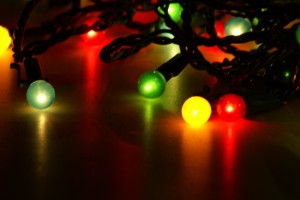More than 50,000 home fires are started by electrical problems every year, according to the National Fire Protection Association (NFPA). Holiday lighting and decorations can put homes at a higher risk because they are used infrequently. Stay safe this holiday season with these tips from the NFPA and ESFI (Electric Safety Foundation International).
Shopping tips:
 Only purchase UL (Underwriters Laboratories) listed lights, electric decorations, and extension cords. Be sure that you only purchase electrical decorations and lights from reputable retailers; read labels carefully and check for lights that have been approved for safe use by a nationally recognized testing laboratory. Counterfeit lighting and decorations can put you and your family at risk. The easiest way to be sure you are not purchasing a counterfeit product is to inspect the label carefully and purchase from a reputable retailer.
Only purchase UL (Underwriters Laboratories) listed lights, electric decorations, and extension cords. Be sure that you only purchase electrical decorations and lights from reputable retailers; read labels carefully and check for lights that have been approved for safe use by a nationally recognized testing laboratory. Counterfeit lighting and decorations can put you and your family at risk. The easiest way to be sure you are not purchasing a counterfeit product is to inspect the label carefully and purchase from a reputable retailer.
Check ratings:
If you decorate with outdoor lights, be sure that the lights and decorations you use are rated for outdoor use to avoid fire hazards and potential electric shock. The color-coded UL mark on the product’s package provides an easy way to check: a green holographic UL mark is rated for indoor use only, while a red one shows that a product is safe for both indoor and outdoor use.
Placement:
Unless you are using LEDs, be sure that no more than three light strands will be strung together in your holiday decorating. LED lights use less energy and run cooler than traditional holiday lights. Plan ahead to be sure that outlets won’t be overloaded and cords won’t be pinched in doors, windows, or by heavy furniture, all of which can damage the cord’s insulation. Always follow the manufacturer’s use and care instructions. Be sure to match the amperage of electrical products with the amperage rating of any extension cords used.
Lights out:
Turn off all indoor and outdoor electrical decorations before going to sleep or leaving your home.
Outdoor lighting:
Plug outdoor lighting and decorations into circuits that are protected by ground fault circuit interrupters, also known as GFCIs. If your circuits are not GFCI-protected, you can purchase portable outdoor GFCIs at stores where electrical supplies are sold. Be sure that all extension cords and electrical decorations used outdoors are marked for outdoor use. Be sure to fasten outdoor lighting securely, but be careful that you don’t attach the lights in a way that may damage the cord’s insulation. Use wooden or fiberglass ladders for hanging outdoor decorations, as metal ladders conduct electricity.
Unplug safely:
When unplugging electric decorations, be sure to use the gripping area on the plug—never pull the cord to unplug from an outlet. This can damage the cord’s wire and insulation, possibly leading to an electrical shock or fire.
Make repairs:
Always unplug before making any repairs such as changing bulbs or replacing fuses. If you are replacing a bulb, check the wattage rating of the replacement bulb to be sure that it matches the wattage rating of the light strand or decoration. If you use a bulb with too high a wattage, the string can overheat, which creates a fire risk.
Inspect:
Take the time to really look at your string lights and other decorations requiring electricity as you decorate this year and as you put your decorations away at the end of the holiday season. Do not use lighting that is damaged. This includes lights with loose connections, broken sockets, or cracked/bare wires.
Storage:
Wrap each set of lights around a piece of cardboard or place them in individual plastic storage bags. Be sure to keep your electrical decorations in a dry location and away from children and pets.
If you or someone you love has suffered from an injury sustained due to lighting equipment malfunction, call the lawyers at Schuerman Law to learn how to get the justice and compensation you deserve. Call 1-800-274-0045 to schedule your free consultation today.

